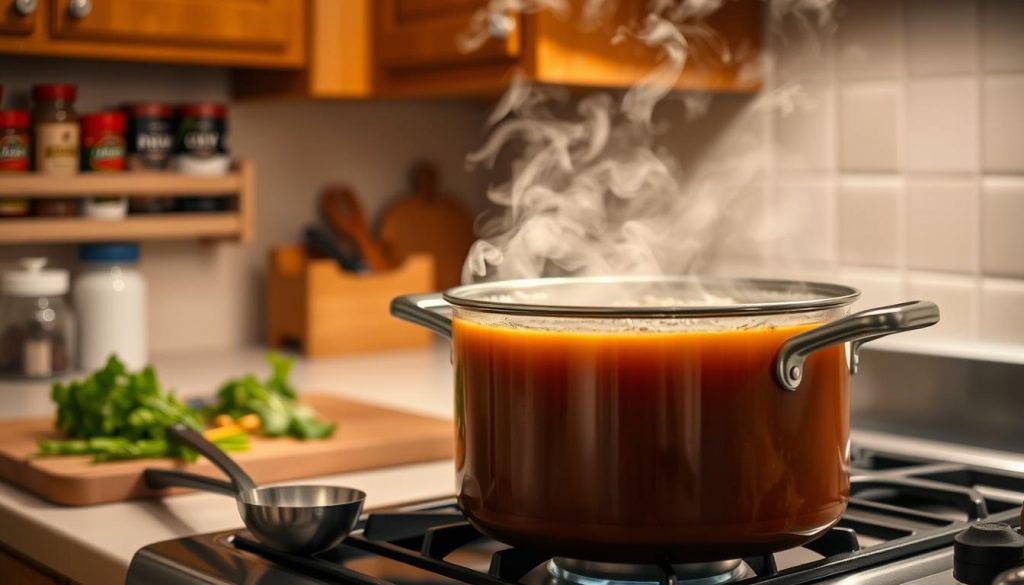Beef stock adds rich flavor to many dishes. Keeping it fresh and safe is crucial. Let’s explore beef broth shelf life and proper refrigerated storage tips.
Understanding storage methods is key for both homemade and store-bought stock. We’ll cover freshness indicators and optimal storage techniques. This will help you make the most of this versatile ingredient.
Learn how to keep your broth fresh and flavorful. Our expert tips will help you avoid common mistakes. You’ll ensure your stock is always ready when needed.
Key Takeaways
- Proper storage extends beef stock shelf life
- Refrigeration is crucial for maintaining stock freshness
- Homemade beef stock storage differs from store-bought
- Temperature control is vital for stock preservation
- Regular checks help identify signs of spoilage
- Correct containers and labeling improve storage efficiency
Understanding Beef Stock Basics and Its Components
Beef stock adds depth and richness to many dishes. It’s a key ingredient in kitchens worldwide. Let’s explore this flavorful base and its forms.
What Makes Up a Good Beef Stock
A top-notch beef stock needs key ingredients. Beef bones, full of collagen, are the main component. Onions, carrots, and celery add depth.
Herbs and spices like bay leaves and peppercorns boost flavor. These elements combine to create a rich, tasty stock.
Different Types of Beef Stock
Beef stock comes in several varieties:
- Traditional beef stock: Made from roasted bones and vegetables
- Bone broth: Simmered for longer periods, extracting more nutrients
- Beef consommé: A clarified, concentrated stock
- Bouillon cubes: Dehydrated stock for quick reconstitution
Homemade vs. Store-Bought Stock
Homemade stock lets you control ingredients and flavor. Store-bought options offer convenience. Let’s compare:
| Aspect | Homemade Stock | Store-Bought Stock |
|---|---|---|
| Flavor | Rich, customizable | Consistent, but may lack depth |
| Ingredients | Fresh, selected by you | Often includes preservatives |
| Preparation Time | Several hours | Ready to use |
| Cost | Varies, can be economical | Generally more expensive |
Knowing these basics helps you make smart choices. You can pick the right stock for your cooking needs.
How Long Does Beef Stock Last in the Fridge
Beef stock’s fridge life depends on various factors. Homemade stock usually lasts 3-4 days when stored correctly. Store-bought types often contain preservatives, lasting 4-5 days after opening.
To extend beef stock’s life, use airtight containers. Glass jars or plastic containers are ideal. Avoid metal containers as they can alter the taste.
Cool stock to room temperature before refrigerating. This prevents bacteria from growing. Always check for spoilage signs before using the stock.
Here’s a quick guide to beef stock storage times:
| Type of Beef Stock | Refrigerator Storage Time |
|---|---|
| Homemade (No Preservatives) | 3-4 days |
| Store-Bought (Opened) | 4-5 days |
| Store-Bought (Unopened) | Check expiration date |
These are general guidelines for stock shelf life. Trust your senses to check for freshness. If in doubt, it’s safer to discard the stock.
Signs of Fresh vs. Spoiled Beef Stock
Spotting the difference between fresh and spoiled beef stock is vital for food safety. This guide will help you identify visual cues, smell changes, and texture alterations. These tips will enable you to test stock freshness reliably.
Visual Indicators of Freshness
Fresh beef stock should have a clear, golden-brown color. Be cautious if you see cloudiness, floating particles, or a film on the surface. Mold growth, appearing as fuzzy spots in various colors, indicates spoilage.
Smell and Texture Changes
Fresh beef stock has a rich, meaty aroma. If it smells sour, rancid, or off, it’s likely spoiled. The texture should be smooth and slightly gelatinous when cold.
Discard the stock if it’s slimy or has an unusual consistency.
Warning Signs of Spoilage
Be alert for these red flags that indicate your beef stock has gone bad:
- Bubbling or fizzing when not being heated
- Separation of fat that doesn’t reincorporate when stirred
- Unpleasant or strong odors
- Changes in color or clarity
| Characteristic | Fresh Beef Stock | Spoiled Beef Stock |
|---|---|---|
| Color | Clear, golden-brown | Cloudy, discolored |
| Smell | Rich, meaty aroma | Sour, rancid odor |
| Texture | Smooth, slightly gelatinous when cold | Slimy, unusual consistency |
| Surface | Clear | Film or mold present |
If you’re unsure, it’s best to discard the stock. Safety is more important than risking foodborne illness. Regular freshness checks help maintain food safety in your kitchen.
Proper Storage Containers and Methods
Picking the right containers for beef stock keeps it fresh and tasty. We’ve looked at several options to help you choose the best one for your kitchen.

Glass jars are great for storing beef stock. They’re non-reactive, easy to clean, and see-through. Mason jars with tight lids work well for short-term fridge storage.
Plastic containers are versatile and durable. Choose BPA-free, freezer-safe options for longer storage. These lightweight containers are perfect for portioning and stacking.
Always use airtight containers for best results. They keep air out and maintain stock quality. Vacuum-sealed bags are great for freezer storage, reducing freezer burn.
| Container Type | Best For | Pros | Cons |
|---|---|---|---|
| Glass Jars | Refrigeration | Non-reactive, Easy to clean | Breakable, Heavier |
| Plastic Containers | Freezing | Lightweight, Stackable | May absorb odors |
| Vacuum-Sealed Bags | Long-term freezing | Space-saving, Prevents freezer burn | Requires special equipment |
Label your containers with the preparation date. This helps track freshness and ensures you use the oldest stock first. Using the right storage methods will keep your homemade beef stock delicious longer.
Temperature Guidelines for Storing Beef Stock
Proper temperature control keeps beef stock safe and delicious. Let’s look at the best ways to store your stock safely.
Optimal Fridge Temperature Settings
Set your refrigerator to the right temperature for food safety. The best range for beef stock is 35°F to 38°F (1.7°C to 3.3°C).
This cool environment slows down bacterial growth. It also keeps your stock fresh for longer.
Danger Zone Temperatures
Beef stock becomes unsafe in the “danger zone” – 40°F to 140°F (4.4°C to 60°C). Harmful bacteria grow fast in this range.
Don’t leave stock at room temperature for over two hours. This helps prevent foodborne illness.
Impact of Temperature Fluctuations
Steady refrigerator settings preserve beef stock quality. Frequent temperature changes can make food spoil faster.
Check your fridge often to ensure it stays at the right temperature. This helps keep your food safe.
| Temperature Range | Effect on Beef Stock | Storage Duration |
|---|---|---|
| Below 32°F (0°C) | Freezing, extends shelf life | Up to 6 months |
| 35°F – 38°F (1.7°C – 3.3°C) | Optimal refrigeration | 3-4 days |
| 40°F – 140°F (4.4°C – 60°C) | Danger zone, rapid bacteria growth | 2 hours maximum |
| Above 140°F (60°C) | Too hot, promotes spoilage | Not recommended |
Follow these guidelines to keep your beef stock fresh and safe. Check your fridge settings often for the best results.
Freezing Beef Stock for Extended Storage
Freezing beef stock preserves its rich flavor and nutritional value. Frozen beef stock can last up to 6 months while maintaining quality. Let’s explore effective freezing techniques for your homemade or store-bought stock.
The ice cube tray method is popular for freezing beef stock. It allows for easy portioning and quick thawing. Pour cooled stock into ice cube trays and freeze.
Once solid, transfer the cubes to a freezer-safe bag or container. This makes it easy to grab the right amount for recipes.
For larger portions, use freezer-safe containers or bags. Leave about an inch of space at the top for expansion. Lay bags flat in the freezer for efficient storage.
Remember to label each container with the date and contents. This helps you keep track of your frozen stock.
| Storage Method | Portion Size | Best Uses |
|---|---|---|
| Ice cube trays | 1-2 oz | Sauces, gravies |
| Small containers | 1-2 cups | Soups, risottos |
| Large containers | 4+ cups | Stews, braising |
To use frozen beef stock, thaw it in the refrigerator overnight. For quick thawing, use the microwave’s defrost setting. Stir occasionally to ensure even thawing.
These simple freezing techniques ensure you’ll always have flavorful beef stock on hand. Your culinary creations will thank you!
Best Practices for Handling and Storing Stock
Proper stock storage is vital for efficient kitchen management. Let’s look at cooling methods, storage tips, and labeling systems. These practices keep beef stock fresh and safe.
Cooling Methods Before Storage
Quick cooling preserves stock quality. Fill your sink with ice and place the hot stock pot in it. Stir occasionally to cool faster.
After cooling, transfer the stock to storage containers. This step ensures food safety and maintains flavor.
Portioning Tips for Storage
Smart portioning saves time and reduces waste. Freeze stock in ice cube trays for small amounts. Use 1-cup containers for larger recipe portions.
This method allows easy thawing of just what you need. It’s a practical approach to stock management.
Labeling and Dating System
Clear labels are crucial for food storage organization. Use waterproof labels to mark containers with contents and date. This helps track freshness and use older stock first.
| Storage Method | Shelf Life | Best Practices |
|---|---|---|
| Refrigerator | 3-4 days | Store in airtight containers |
| Freezer | 4-6 months | Use freezer-safe containers |
| Pressure Canned | 1-2 years | Store in cool, dark place |
These cooling and organization strategies boost kitchen management skills. You’ll always have fresh beef stock ready for your culinary creations.
Reheating and Using Stored Beef Stock
Reviving stored beef stock is crucial for home cooks. Careful reheating keeps its rich flavor intact. Here are tips to make the most of your culinary gem.

Use a clean pot and heat stock slowly over medium-low heat. This preserves flavors and prevents scorching. Stir occasionally for even heating.
Hot stock is versatile in cooking. Here are creative ways to use leftover stock:
- Use it as a base for hearty soups and stews
- Cook grains like rice or quinoa in stock for added flavor
- Deglaze pans to create rich sauces
- Braise meats for tender, flavorful results
Safety is key. Don’t leave reheated stock at room temperature for over two hours. Cool it quickly if not using immediately.
“Beef stock is liquid gold in the kitchen. It’s the foundation of countless dishes, adding depth and richness to everything it touches.”
Master stock reheating to elevate your cooking. Explore new uses for leftover stock. Your meals will transform as you reduce food waste.
Common Storage Mistakes to Avoid
Proper beef stock storage is vital for quality and safety. We’ll explore common mistakes that can spoil your stock. Learn how to avoid these errors and keep your kitchen hygienic.
Cross-Contamination Risks
Cross-contamination can ruin your beef stock. Keep it away from raw meats and other contaminants. Use special containers and clean tools for stock handling.
This simple step helps prevent harmful bacteria from spreading. It’s a key practice for maintaining food safety in your kitchen.
Temperature Control Errors
Correct temperature is crucial for beef stock preservation. Leaving stock out too long can cause rapid bacterial growth. Cool your stock quickly before refrigerating.
Ensure your fridge stays below 40°F (4°C). This prevents spoilage and keeps your stock fresh for longer.
Container Selection Mistakes
The right container keeps stock fresh. Avoid large containers that cool unevenly. Choose shallow, airtight ones for quick cooling and less air exposure.
Label containers with dates to track freshness. This simple step helps you use your stock at its best.
| Common Mistake | Solution |
|---|---|
| Storing stock near raw meats | Use separate shelves or containers |
| Slow cooling before refrigeration | Use an ice bath to cool quickly |
| Using non-airtight containers | Choose containers with tight-fitting lids |
Avoid these storage mistakes to extend your beef stock’s life. Proper storage keeps your stock flavorful and safe. It also maintains a clean kitchen environment.
Tips for Maximizing Shelf Life
Smart storage methods can keep your beef stock fresh and tasty longer. Let’s explore top tips for preserving and maintaining quality stock.
Cool your stock quickly before refrigerating. Use an ice bath or divide it into smaller containers. This prevents bacterial growth and maintains flavor.
Choose airtight containers to keep out unwanted odors and moisture. Keep your fridge at or below 40°F (4°C) for optimal stock preservation.
When freezing, use freezer-safe containers and leave space for expansion. Label everything with dates to track freshness easily.
Avoid repeatedly heating and cooling your stock. Instead, portion it out before storing. This reduces exposure to temperature changes and helps maintain quality.




